In “Reaping the Rewards,” I take a look at the finished product from a crowdfunding campaign. Karmaka was funded in February 2016, and delivered to backers in the fall of 2016. In Karmaka, you begin as lowly dung beetles, working your way up the Karmic Ladder toward transcendence. Lay the groundwork for your next rebirth, or interfere with your opponents, but remember: what goes around, comes around.
At a glance: Karmaka is a game from Hemisphere Games for 2 to 4 players, ages 14 and up, and takes 30–60 minutes to play. It retails for $30 and is available in stores and online now. I think the game could be played by younger players if they have some experience with cards that interact with each other. The game can include direct conflict (depending on the players) but it plays out in an interesting way.
Karmaka is GeekDad Approved!
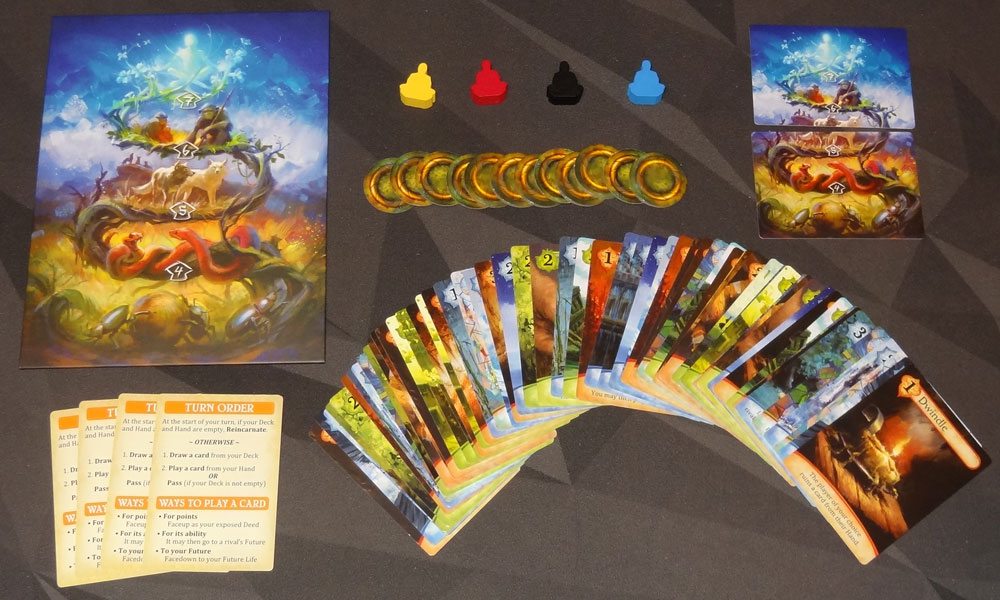
Components:
- 64 game cards:
- 19 red cards
- 19 green cards
- 19 blue cards
- 7 mosaic cards
- 12 Karmic Rings
- 1 Karmic Ladder
- 2 Karmic Ladder cards
- 4 player tokens
- 4 reference cards

The “Karmic Ladder” is the game board, which is a short track from dung beetle to transcendence. It has a lovely illustration, with each level showing a different type of animal and a small arrow with a number between the levels. There are only 5 locations, so the board is technically larger than it needs to be, but it does showcase Lane Brown’s artwork. There’s also a portable Karmic Ladder—the illustration is split between two cards, so that if you wanted to ditch the box and just pack the cards and tokens in your pocket, you could reduce the size significantly.
The cards are lovely, and each color has a different sort of theme. Red cards tend to be destructive, Green cards tend to get you more cards, and Blue cards are sneaky. Mosaic cards are wild, and can be counted as any color. The artwork on them (by Marco Bucci) is lovely and the card abilities are thematically tied to the names of the cards. Each card is like a little painting.
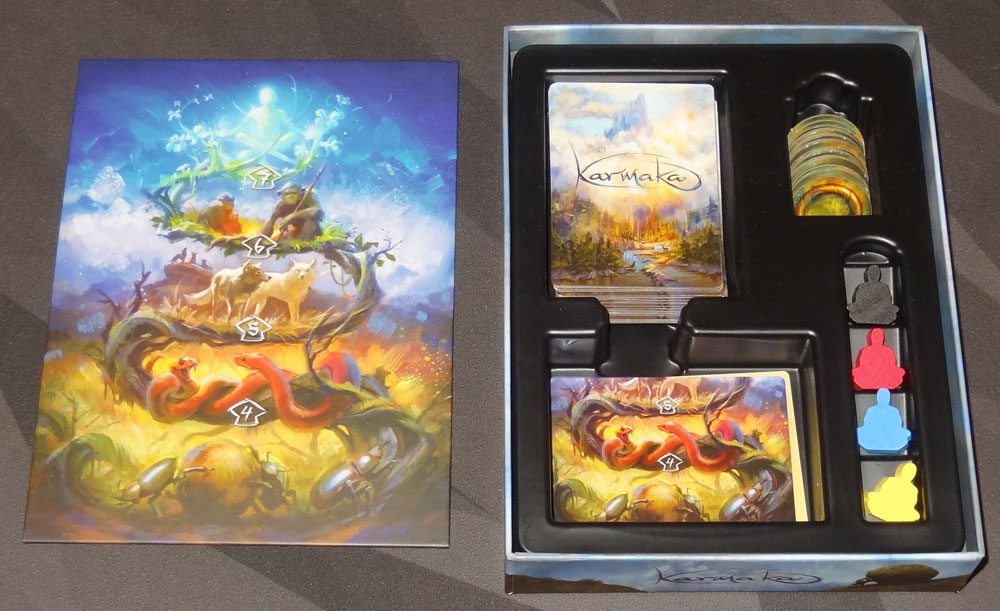
The Karmic Rings are cardboard tokens, and the player pawns are wooden buddha-shaped meeples. The box is sized to match the Karmic Ladder board, and the insert has wells for everything, including two card wells in case you sleeve your cards. I would have been okay with everything being in an even smaller box, but then the Karmic Ladder would have to be a folding board.
Overall, everything is pretty close to the prototype version, except for the player pawns.
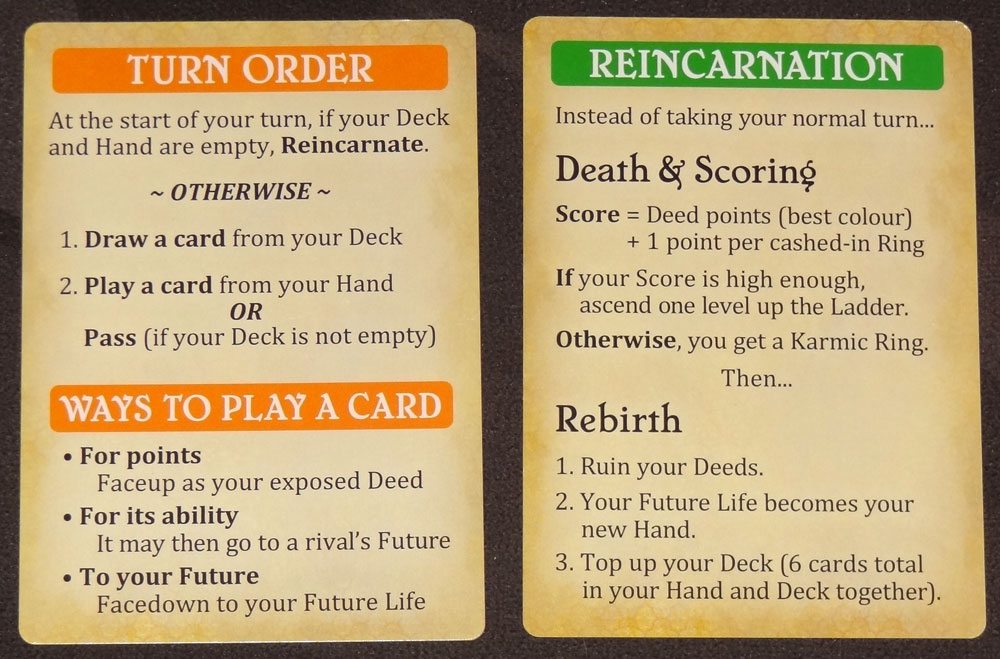
How to Play
You can download a free print and play here if you’d like to try the game out.
The object of the game is to be the first to reach transcendence at the top of the Karmic Ladder.
To set up, each player takes a player token and places it on the dung beetle level of the Karmic Ladder. The Karmic Rings are placed near the board to form a supply. All the cards are shuffled together, forming the Well. Each player starts with a hand of 4 cards from the Well, and also gets 2 more cards (face-down) as a personal deck. The player with the worst luck goes first.
In this game, there’s a central deck called the Well and a central discard pile called the Ruins. Each player will also have a hand of cards and three sets of cards: a deck, a Deeds pile, and a Future Life pile. The deck and Future Life are face-down, and the Deeds are face-up.
On your turn, you draw a card (from your deck) and then play a card. If your deck is empty, you just skip the draw phase. If your deck is not empty, you may skip the “play a card” phase.
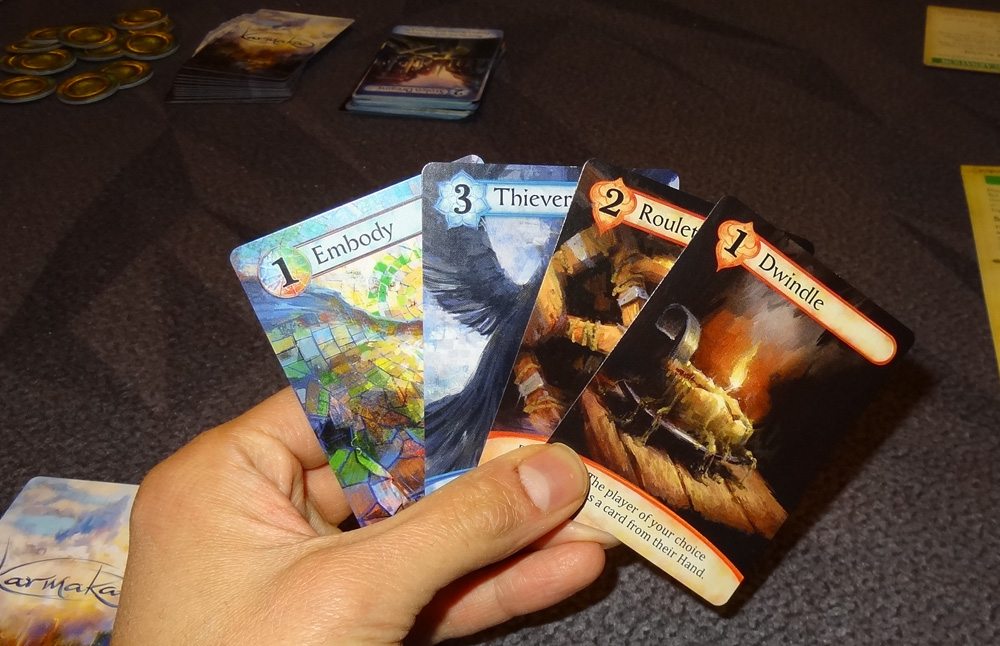
You play a card in one of three ways:
- Points: Place it face-up in your Deeds area. (Ignore the ability.)
- Ability: Read the card’s effect and do what it says. Then it gets offered to your opponents. If the card directly affected one player, you offer it to that player, otherwise it gets offered to each player in clockwise order. If somebody claims the card, it goes face-down in their Future Life pile. If no other players claim it, it goes in the Ruins.
- Future Life: You may place a card face-down in your Future Life pile.
Then it’s the next player’s turn.
If you start your turn and you have no cards in your hand or deck, then your life is over. You will not play any cards this turn–you just score and reincarnate.

Score your Deeds pile: only one color will count, so add up your cards and pick the color with the highest score. Wild cards can count as any color. If you achieve at least enough points to move up to the next rung on the Karmic Ladder, then you ascend and move your pawn. Otherwise, you take a Karmic Ring from the supply. Karmic Rings can be spent to increase your score.
Either way, all of your Deeds are then discarded to the Ruins. Then, draw all of the cards in your Future Life to form your new hand. Finally, if you have fewer than 6 cards in your hand, deal cards (face-down) from the Well into your deck until you have a total of 6 cards in your hand and deck combined.
The game ends as soon as a player reaches the top of the Karmic Ladder and wins.
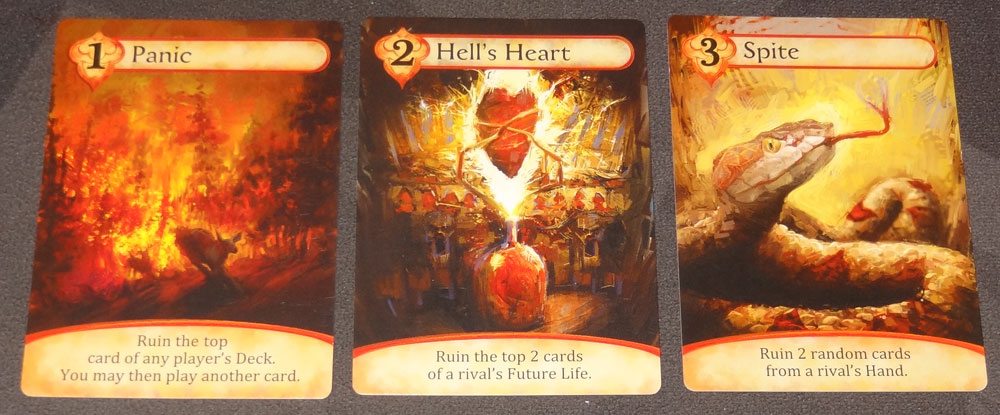
The Verdict
Karmaka was designed by Eddy Boxerman and Dave Burke of Hemisphere Games, and it’s their first tabletop game. If Hemisphere Games sounds familiar, it’s because of their video game, Osmos. Where Osmos immersed you in a world of eat-or-be-eaten motes, Karmaka is about a cycle of death and rebirth, and karma.
Probably the most intriguing aspect of Karmaka is the way that it integrates the concept of karma: your actions in this life will have repercussions down the road. Any time you play a card that affects somebody directly, that opponent has the opportunity to take the card. While that doesn’t guarantee that the card will be played back onto you, it’s possible. It might get played on another player, who then takes it, and plays it on you. However it works, there is an overall sense of karmic balance.
But as you play the game, you’ll discover other things that are interesting: for one, sometimes you don’t want to prolong your life. There’s a card called Longevity that lets you add cards to your current deck–that could be helpful if you haven’t scored enough Deeds yet to ascend the ladder. However, you can’t reincarnate and ascend until you die (run out of cards), so sometimes Longevity can be used to keep a rival stuck in their current life just a few more turns instead.

The lives are generally fairly short–usually only 6 cards, unless you’ve managed to stash a whole lot in your Future Life–so you live, die, and reincarnate often. Since you get a Karmic Ring every time you reincarnate but don’t ascend, eventually you’ll have enough socked away to climb the ladder–the trick is getting there before your opponents do.
Since you only score points for a single color each life, one strategy tip the rulebook gives is to look at your hand, pick a color to put into Deeds, and pick another color to put into your Future Life. Sometimes that means deciding between helping yourself in the future or playing a card for its ability that might hinder an opponent here and now. It’s also interesting that, the fewer cards you have in your Future Life, the less you’re able to plan ahead, because your deck will be made of random cards from the Well.
I like the different colors and types of abilities. Green cards feel like they’re about growth: drawing cards from the Well or the Ruins. Red cards tend to destroy things: you might discard cards from somebody’s Future Life, or even their current life’s Deeds, preventing them from ascending. Blue cards let you steal things or move things around. The mosaic cards tend to copy other effects, like something from your own Deeds or from another player’s Deeds.
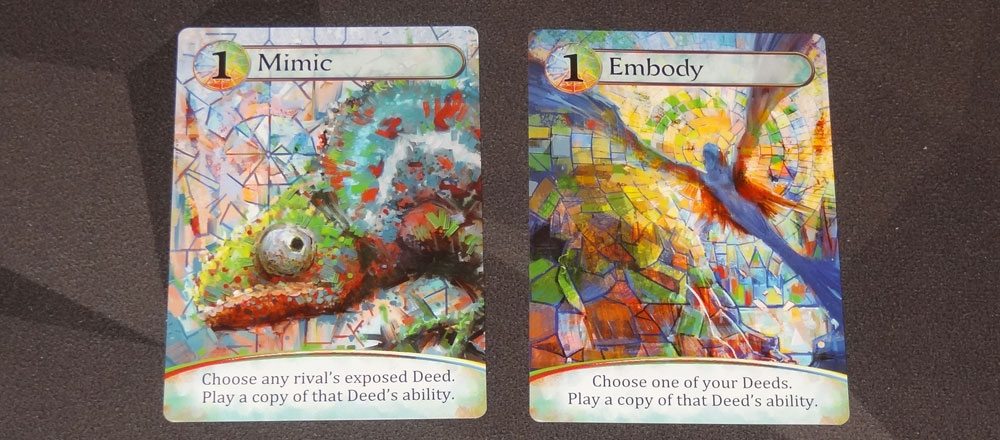
I will warn you: Karmaka seems like it’s going to be a light game, but it’s deeper than it looks. Each turn you either play a card for its effect, as a Deed, or in your Future Life (or pass)—doesn’t sound too complicated, right? But which card to use, and how to use it, can actually be an excruciating decision. The choices you make can be tough, and I’ve had friends be surprised by how tricky the game can be. But I love games that let you make difficult, meaningful choices, and Karmaka certainly fits the bill.
The game can go a little long if you have players who have trouble making a decision about what to play–particularly in the situation where they’re copying an ability and they’re asking everyone to read all of their Deeds–but after a few rounds the pace usually picks up as players become more familiar with the various cards.
I’ve played the finished version of the game a few times now, and I was reminded how much I enjoyed playing the prototype. I like the various approaches you can take—focus on your own growth or sabotage other players—on the path to enlightenment. Overall, I’ve enjoyed Karmaka, and I particularly enjoyed the way that cards you play can be taken by other players. It’s a fascinating mechanic, because it gives you pause before using the more powerful abilities, and it has an interesting effect on the nature of player interaction.
Disclosure: I received a review copy of this game.

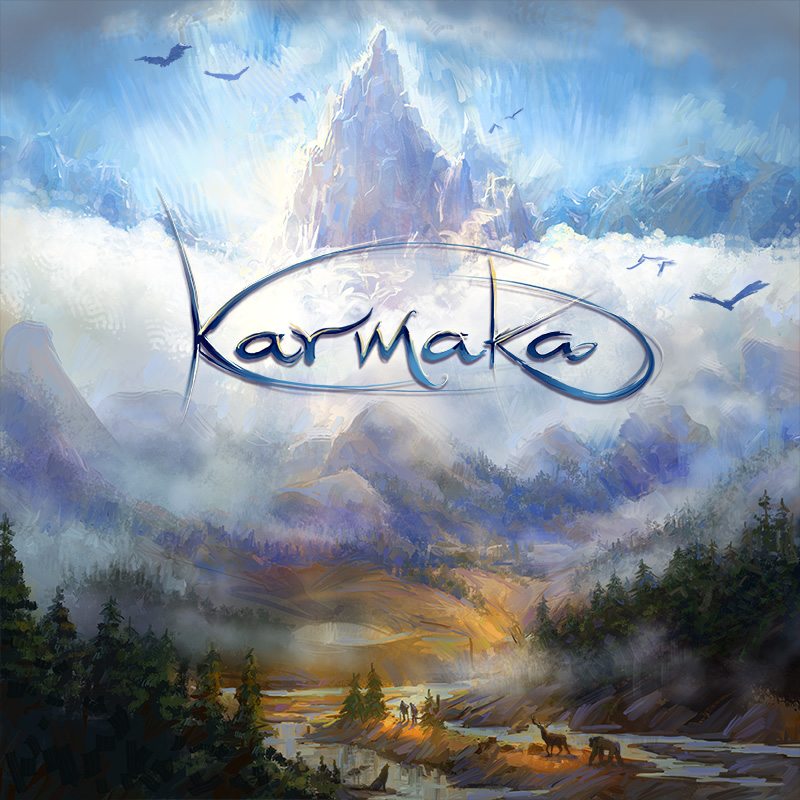

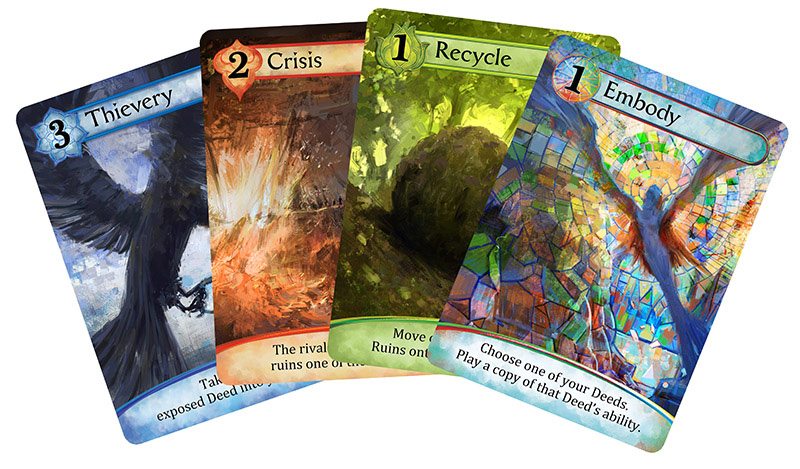



Is this game available for purchase yet or is it still in its Kickstarter stages?
Hi! This one is available for purchase now—it was Kickstarted last year and delivered to backers in late 2016. You can look for it at board game stores, or order it online: http://amzn.to/2phrGGi